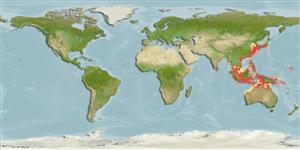>
Eupercaria/misc (Various families in series Eupercaria) >
Sparidae (Porgies)
Etymology: Argyrops: Greek, argyros = silver, silvered + Gree, ops = appearance (Ref. 45335).
Environment: milieu / climate zone / depth range / distribution range
Ecología
marino; salobre demersal; rango de profundidad 50 - 200 m (Ref. 124569). Tropical
Western Pacific: Japan to Australia.
Tamaño / Peso / Age
Maturity: Lm ? range ? - ? cm
Max length : 50.0 cm SL macho / no sexado; (Ref. 124569); common length : 30.0 cm SL macho / no sexado; (Ref. 124569)
Espinas dorsales (total): 10 - 11; Radios blandos dorsales (total): 9-11; Espinas anales 3; Radios blandos anales: 8 - 9. This species is distinguished from all its congeners by the following set of characters: body deep and compressed; D XI,10 (rarely X,11); first dorsal-fin spine rudimentary (one dorsal-fin spine on first dorsal pterygiophore), the second to sixth spines (usually 5, rarely 4) are much elongated and flattened in juveniles 15-25 cm SL (second spine often reaching beyond level of last dorsal soft rays, shorter and reaching first soft dorsal-fin ray base in specimens of ca. 30 cm SL); orbit diameter clearly less than suborbital depth; pupil diameter greater than preorbital length in specimens less than 20 cm SL, but pupil diameter is clearly less than preorbital length (more noticeable in specimens greater than approx. 30 cm SL; the rear margin of upper jaw extends to a vertical beyond orbit diameter; body bars reddish, often present to 25 cm SL; all fins reddish hyaline (Ref. 124569).
Inhabits sandy and muddy bottoms (Ref. 41299). Important food fish. In Okinawa (Japan), according to local fishermen, this species usually reches more thatn 50 cm SL and a buyer from Ryukyu Is. reported that some individuals occasionally attain 65 cm SL (Ref. 124569).
Life cycle and mating behavior
Madurez | Reproducción | Puesta | Huevos | Fecundidad | Larva
Iwatsuki, Y. and P.C. Heemstra, 2018. Taxonomic review of the genus Argyrops (Perciformes; Sparidae) with three new species from the Indo-West Pacific. Zootaxa 4438(3):401-442. (Ref. 124569)
IUCN Red List Status (Ref. 130435)
Threat to humans
Harmless
Human uses
Pesquerías: comercial
Más información
Nombres comunesSinónimosMetabolismoDespredadoresEcotoxicologíaReproducciónMadurezPuestaAgregación para la puestaFecundidadHuevosEgg development
ReferenciasAcuiculturaPerfil de acuiculturaRazasGenéticaElectrophoresesheritabilidadEnfermedadesProcesamientoNutrientsMass conversion
ColaboradoresImágenesStamps, Coins Misc.SonidosCiguateraVelocidadTipo de nataciónSuperficie branquialOtolitosCerebrosVisión
Herramientas
Special reports
Download XML
Fuentes de Internet
Estimates based on models
Preferred temperature (Ref.
123201): 17.4 - 28.2, mean 26.4 °C (based on 780 cells).
Phylogenetic diversity index (Ref.
82804): PD
50 = 0.5625 [Uniqueness, from 0.5 = low to 2.0 = high].
Bayesian length-weight: a=0.02089 (0.00974 - 0.04480), b=2.97 (2.80 - 3.14), in cm total length, based on LWR estimates for this (Sub)family-body shape (Ref.
93245).
Nivel trófico (Ref.
69278): 4.5 ±0.8 se; based on diet studies.
Resiliencia (Ref.
120179): Bajo, población duplicada en un tiempo mínimo de 4.5-14 años (Preliminary K or Fecundity.).
Fishing Vulnerability (Ref.
59153): Moderate vulnerability (44 of 100).
